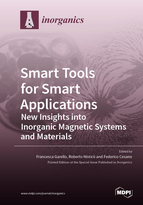Smart Tools for Smart Applications: New Insights into Inorganic Magnetic Systems and Materials
A special issue of Inorganics (ISSN 2304-6740). This special issue belongs to the section "Inorganic Solid-State Chemistry".
Deadline for manuscript submissions: closed (31 July 2020) | Viewed by 62756
Special Issue Editors
Interests: magnetic resonance imaging; NMR techniques; relaxometry; MRI contrast agents; nanoparticles and microparticles; SPIO; sonosensitive systems; targeted drug delivery; controlled drug delivery; theranostics
Special Issues, Collections and Topics in MDPI journals
Interests: bio-based materials; biochars; composites; functional coatings; iron oxides; magnetic materials; nanomaterials; photocatalysis; polymorphs; porous materials and coatings; sol-gel; templating
Special Issues, Collections and Topics in MDPI journals
Interests: composite/hybrid materials and nanomaterials; surface Science; microscopies and spectroscopies; catalysis and photocatalysis
Special Issues, Collections and Topics in MDPI journals
Special Issue Information
Dear Colleagues,
In recent years, micro- and nanosystems with magnetic properties have been extensively investigated in many fields, ranging from physics to medicine. The research in these areas has lately shown that, if the magnetic compounds are opportunely functionalized and modified with moieties and specific functional groups, a plethora of challenging multidisciplinary applications is available, including the development of magnetically-controlled particles, stimuli-responsive materials, magnetically-guided chemical/drug-delivery systems, sensors, spintronics, separation and purification of contaminated groundwater and soils, ferrofluids and magnetorheological fluids, contrast agents for MRI, internal sources of heat for the thermo-ablation of cancer, and so on. Magnetic compounds have been found to be highly selective and effective in all these application fields, from the molecular level to the microscale one. This Special Issue aims at underlining the latest advances in the field of magnetic compounds, nanosystems and materials, covering a large variety of topics related to: Novel synthesis and functionalization methods, properties, applications and use of magnetic systems in chemistry, materials science, diagnostics and medical therapy.
Dr. Francesca Garello
Dr. Roberto Nisticò
Dr. Federico Cesano
Guest Editors
Manuscript Submission Information
Manuscripts should be submitted online at www.mdpi.com by registering and logging in to this website. Once you are registered, click here to go to the submission form. Manuscripts can be submitted until the deadline. All submissions that pass pre-check are peer-reviewed. Accepted papers will be published continuously in the journal (as soon as accepted) and will be listed together on the special issue website. Research articles, review articles as well as short communications are invited. For planned papers, a title and short abstract (about 100 words) can be sent to the Editorial Office for announcement on this website.
Submitted manuscripts should not have been published previously, nor be under consideration for publication elsewhere (except conference proceedings papers). All manuscripts are thoroughly refereed through a single-blind peer-review process. A guide for authors and other relevant information for submission of manuscripts is available on the Instructions for Authors page. Inorganics is an international peer-reviewed open access monthly journal published by MDPI.
Please visit the Instructions for Authors page before submitting a manuscript. The Article Processing Charge (APC) for publication in this open access journal is 2200 CHF (Swiss Francs). Submitted papers should be well formatted and use good English. Authors may use MDPI's English editing service prior to publication or during author revisions.
Keywords
- Aggregation and manipulation of particles (by magnetic fields)
- Characterization and imaging techniques
- Eco-friendly production of magnetic systems
- Ferrofluids and magnetic liquid technology
- Hyperthermia therapy and treatments by magnetic particles
- Investigation of magnetic properties
- Low-dimensional (0D, 1D, 2D) magnetic systems and compounds, Magnetically-guided chemicals
- Magnetically-guided drug delivery systems
- Magnetic carriers
- Magnetic clusters, Magnetic metals, alloys and metal oxides
- Magnetic micelles or vesicles
- Magnetic motors
- Magnetic nanoparticles and nanomaterials
- Magnetic performance and properties
- Magnetic probes for magnetic resonance imaging (MRI)
- Magnetic properties of coordination compounds and crystals
- Magnetic responsive materials
- Magnetic sensors
- Magnetorheological fluids
- Materials for Magnetic Particle Imaging (MPI)
- Materials/nanomaterials for data storage
- Single-molecule magnets
- Technologies for cleaning and environmental applications
- Technologies for energy production
Benefits of Publishing in a Special Issue
- Ease of navigation: Grouping papers by topic helps scholars navigate broad scope journals more efficiently.
- Greater discoverability: Special Issues support the reach and impact of scientific research. Articles in Special Issues are more discoverable and cited more frequently.
- Expansion of research network: Special Issues facilitate connections among authors, fostering scientific collaborations.
- External promotion: Articles in Special Issues are often promoted through the journal's social media, increasing their visibility.
- Reprint: MDPI Books provides the opportunity to republish successful Special Issues in book format, both online and in print.
Further information on MDPI's Special Issue policies can be found here.







